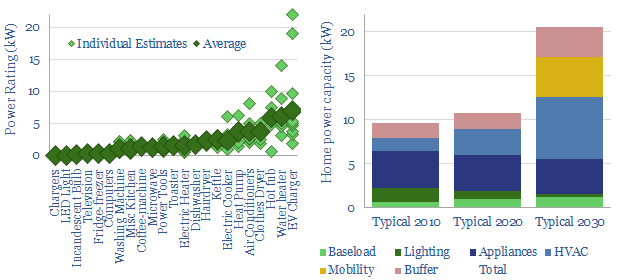This data-file aims to estimate the power capacity required for a typical home circa 2010, 2020 and 2030, under various energy transition scenarios.
Our methodology is to tabulate the typical power consumption of various appliances, then estimate the number of these appliances that would be required.
A typical home in the developed world currently has a 10kW maximum power capacity before tripping its circuit-breaker (although it varies).
This could easily double in the energy transition, due to phasing back gas heating, gas cooking and the addition of home charging stations for electric vehicles.
The only thing is that upgrading the power capacity of a home can typically cost $1,000-5,000, and sometimes as much as $20,000.
We think that constructing more resilient power grids will be a crucial component of the energy transition, and total global power grid capex could quadruple to over $1trn per year.
The data-file contains our estimates for the typical power consumption (in Watts) for 30 types of electronic devices, such as Air Conditioners, Ceiling fans, Chargers, Clothes Dryers, Coffee-machines, Computers, Dishwashers, Electric Cookers, Electric Heaters, Electric Ovens, EV Chargers, Fridge-freezers, Hairdryers, Heat Pumps, Hot tubs, Incandescent Bulbs, Irons, Kettles, LED Lights, Microwaves, Misc Kitchens, Power Tools, Routers, Saunas, Televisions, Toasters, Vacuum Cleaners, Washing Machines, Water heaters.
The data-file also contains estimates for the power factors, total harmonic distortion and fundamental RMS of different types of load. An electric kettle might have less than 2% total harmonic distortion and 0.99 power factor, while a laptop has 150% total harmonic distortion and 0.57.

